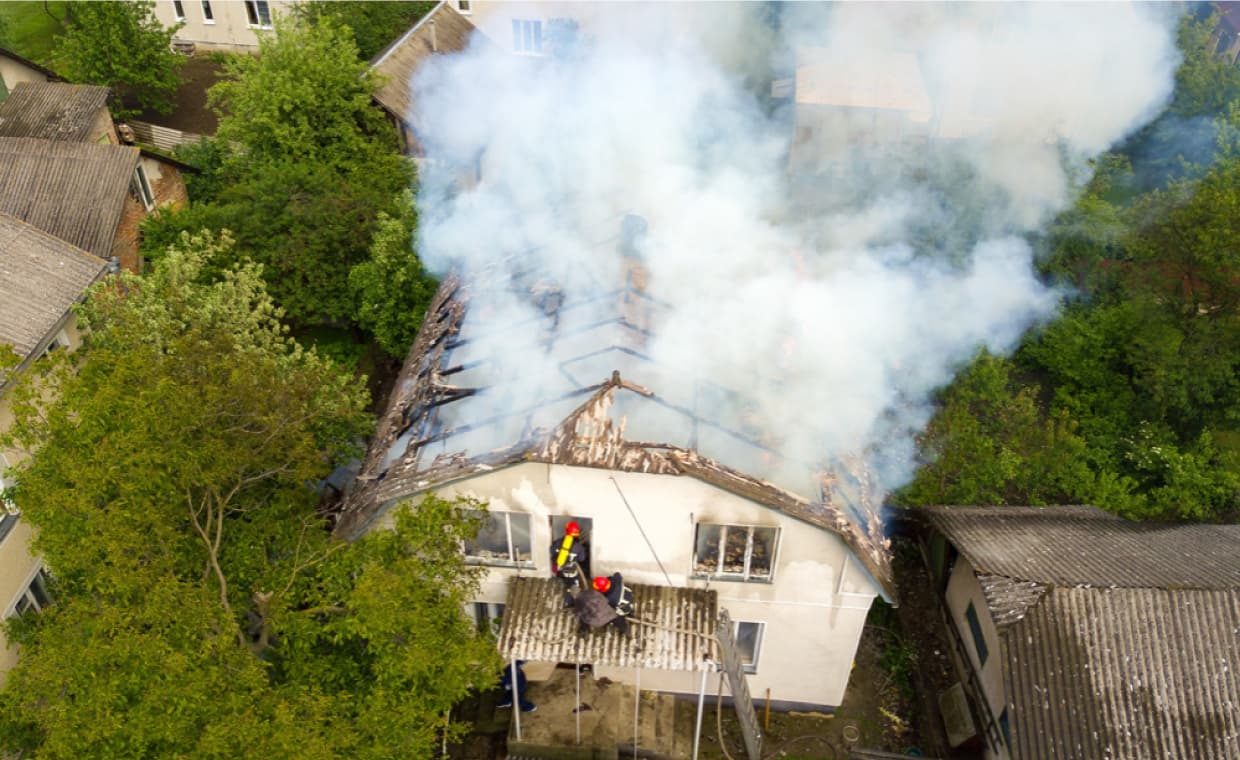
Table of Contents
Quick Review
Restoration of a house becomes necessary after any kind of disaster, whether it is caused by water or fire. The following are the stages of property restoration after water or fire damage:
- Assess the extent of damage to plan a comprehensive restoration strategy.
- Prioritize the safety of your property and obtain a safety clearance from the fire department. In cases of water damage, turn off the electricity and gas supply to prevent hazards.
- The water damage restoration process includes water extraction, dehumidification, drying, and repair work.
- Fire damage restoration includes debris removal, odour and smoke remediation, structural repairs, and inspection of electrical and plumbing systems. All repair work should be carried out using upgraded materials for future resilience.
- Contact your insurance company to file a claim. Keep detailed records of all communication, receipts, and expenses related to restoration.
- Hire a reputable restoration company with certified professionals and proven experience.
- Take precautionary measures to protect your property from future damage.
When the disaster attacks in the form of water or burns, it can be overshadowed later. Like homes and businesses, not only structural destruction, but also emotional and economic stress. Whether it is a burst pipe, flood or fire outbreak, the path for restoration requires a strategic and informed approach. This guide is moving through the necessary stages of restoration of the property, which helps you gain control and rebuild with confidence.
Understand the extent of injury
Before any restoration starts, it is important to assess the damage area. Water damage can vary from weak floods on a full scale, while burns often not only include burnt structures, but also smoke and soot pollution. A professional inspection is recommended to determine the severity and identify hidden problems such as mold growth, compromised electrical systems or weak structural elements. This first assessment determines the basis for a comprehensive restoration scheme.
Security First: Safe Property

Safety should always be the first priority. After the fire, make sure the property is declared safe to enter the fire department. In case of water damage, turn off the current and gas to prevent hazards. Structural instability, contaminated water and air toxin are common risk in damaged properties. During any initial walkthrough, gloves, masks and shoes that protective wheels should be used. If necessary, climb windows and doors to prevent unauthorized access and further damage from weather or barbarity.
Water Damage Restoration Process

Restoration of water damage usually begins with water extraction. Pumps and vacuums are used to remove water quickly to prevent further saturation. When the water is removed, follow drying and dehumidification. This step is important to prevent mold growth, which can begin within a risk of 24 to 48 hours. Specific tools such as air migrants and dehumidifier help restore normal moisture levels.
After drying, cleaning and hygiene phase begins. Water damage often brings contaminants, especially in flood cases. Carpets, upholstery and other porous materials may need to be left if they cannot be cleaned well. Connection treatment is used to prevent mold and bacteria. Finally, repair and reconstruction are done, which may include plaster, floor, insulation and even structural components.
Burn Injury Procedure

Restoration of burns is more complex due to heat, smoke and water combination, which is used to extinguish flames. The first step is to remove the debris. Burnt materials, ash and soot must be emptied to assess what can be overcome. Smoke and soot can enter walls, ceilings and plumbing systems, requiring deep cleaning and deodorant.
Removal of smoking smell is a special process that contains thermal fog, ozone treatment or hydroxylester. These methods neutralize the smell at the molecular level. It helps to remove soot without help cleaning the surfaces with chemical sponges and special cleaners.
Structural repairs follow, which may involve rebuilding walls, roofs, and other damaged areas. Electrical and plumbing systems should be inspected and replaced if compromised. Fire damage often reveals pre-existing vulnerabilities in a property, making this an opportunity to upgrade materials and systems for future resilience.
Working with Insurance Companies

Navigating insurance requirements is an important part of the restoration process. It is necessary to document the damage well with images, videos and written details. Contact your insurance provider as soon as possible and ask a copy of your insurance to understand your coverage. Many restoration companies provide assistance with requirements, including working directly with adjustments to ensure accurate assessment.
Keep track of all communications, receipts and expenses related to restoration. This includes temporary housing, emergency preparedness and replacement of personal goods. Being organized and active can lead to a lot of speed in the requirements process and can maximize your refund.
Choosing the Right Restoration Professionals

Hiring a reputable restoration company can make all the difference. Look for certified professionals like Price Brothers Restoration with experience in both water and fire damage restoration. Certifications from organizations like the Institute of Inspection, Cleaning and Restoration Certification (IICRC) indicate adherence to industry standards. Ask for references, read reviews, and ensure the company is licensed and insured.
A good restoration company will offer a detailed plan, timeline, and cost estimate. They should communicate clearly and be responsive to your concerns. Restoration is not just about rebuilding—it’s about restoring your sense of security and normalcy.
Preventive Measures for the Future
When your property is restored, consider taking preventive measures to reduce future risks. Install smoke detectors and firefighters, and plan regular inspections of the electrical systems. For water damage, ensure proper drainage around your property, maintain the plumbing work and consider installing leaf pump or water leakage detectors.
An emergency preparation plan is also intelligent. Learn your withdrawal routes, keep important documents in a waterproof and fireproof safe, and maintain a list of emergency contacts. Injuries and stress can be reduced to another disaster state by getting ready.
Conclusions: Reconstruction with flexibility
Restoration of properties after water or burns is a challenging journey, but there is also an opportunity to rebuild strong and smarter. Proper approach, with professional support and focus on safety and prevention, you can not only restore your property, but your thoughts. Whether you are a homeowner or a master of a business, understanding the process of restoration—and even planning ahead with tools like a rent affordability calculator—gives you the right to take decisive action and move on with confidence.
Also Read: How to Restore Fire-Damaged Homes in Arizona?
FAQs on Property Restoration
01. How should I start property restoration after fire or water damage?
Begin by arranging a professional inspection to assess the extent and severity of the damage. This helps in planning a safe and effective restoration process.
02. What precautions should be taken before entering a house after water or fire damage?
Wear protective gear such as gloves, masks, and sturdy shoes. Enter only through safe access points like doors or windows, and ensure the property has been declared structurally safe.
03. How can water be extracted from a house after a flood?
Use pumps and wet/dry vacuums to remove standing water. Once water is extracted, promptly dehumidify the property to prevent mold growth.
04. How can I remove burnt or smoky odors after a fire?
Specialized treatments such as thermal fogging, ozone treatment, or hydroxyl generators are used to neutralize smoke odors at the molecular level.
05. What documents are needed to file an insurance claim for property restoration?
Submit photographs, videos, and written records of the damage along with your insurance policy documents. Keep receipts and records of all expenses related to restoration.
06. How do I choose the right restoration company?
Select a company with strong credentials, certifications, and proven experience. Check reviews, ask for references, and ensure they are licensed and insured.






























